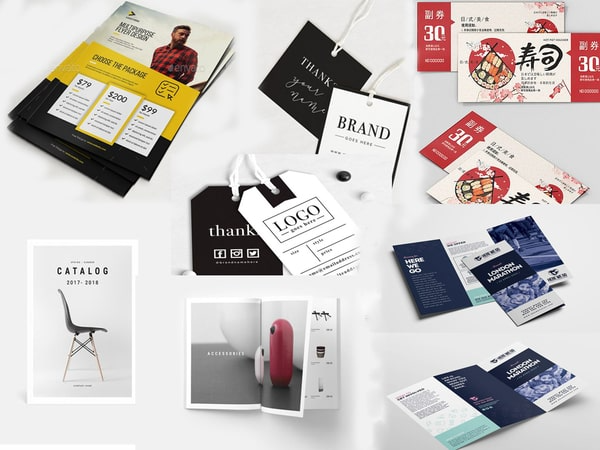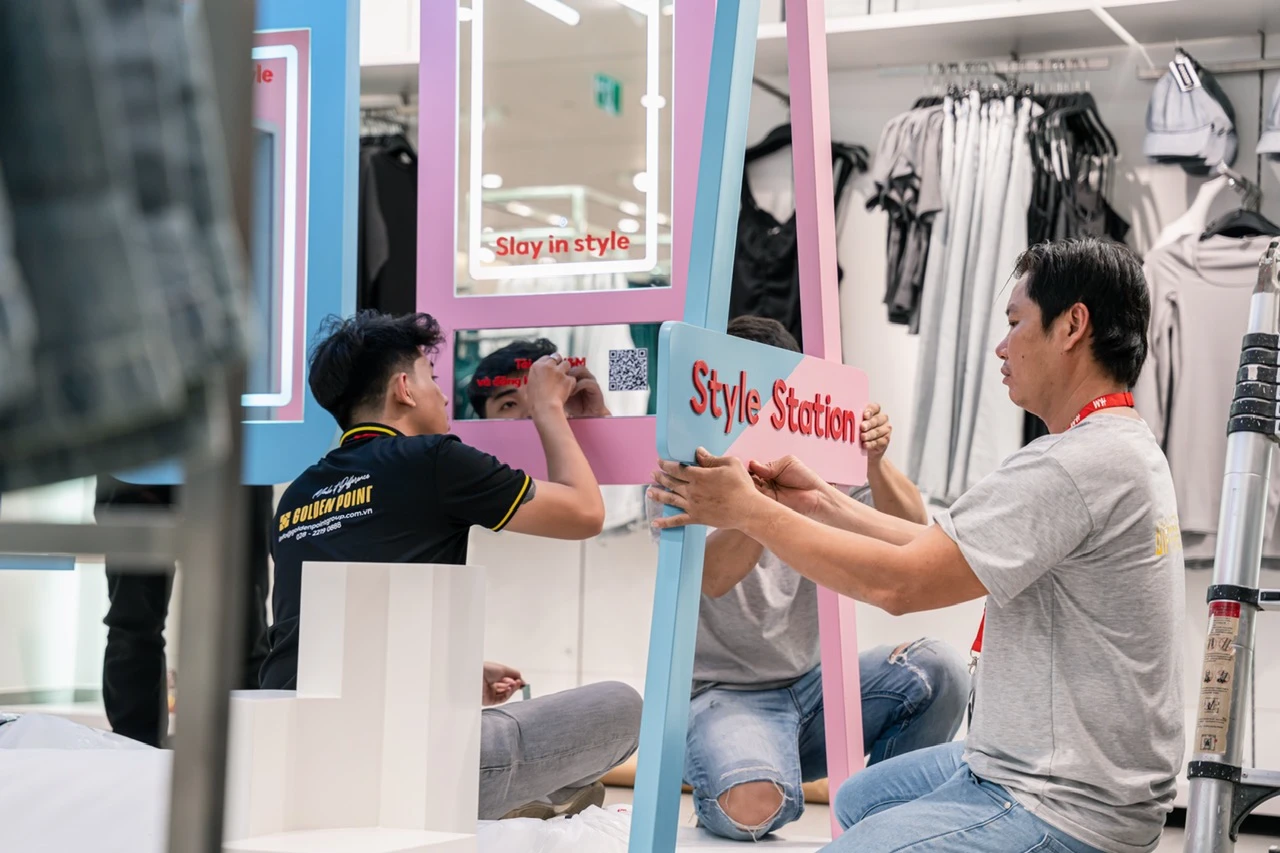
In the field of fashion retail, a fashion store front typically has 3 mannequins, IKEA arranges items like a home, … It’s not by chance that products are placed the way you see them. Each position in the store is carefully calculated to keep customers there longer, which translates to spending more. The job demands both creativity and a business mindset, and it belongs to visual merchandisers. In this article, find out how visual merchandising works, its impact on brands and revenue.
Visual merchandising is succinctly understood as the arrangement of the store, organizing products to attract customers’ attention, encouraging them to buy more, thereby increasing sales revenue.
When walking down a fashion street or shopping center, have you ever stopped in front of a store because you were impressed with the mannequin’s outfit? “Let’s just take a look” - you think, but it’s highly likely that half an hour after stepping out, you will “make a purchase.” The moment you stop and decide to step into the store is when visual merchandising exerts its power.
Visual merchandisers often say to each other: the difficulty of visual merchandising lies in maintaining creative thinking in a commercial environment. Anyone can decorate, but arranging it to express the brand’s personality, conveying a message through images to make viewers love it to the point of opening their wallets is not an easy task. That’s why visual merchandising is a profession!
Mr. Nguyen Viet Dung, lecturer of the Brand Building course (Markus School), shares that “Visual merchandising is not only the first impression of customers with the brand but also influences customers’ shopping behavior and experience.”
Think back to the times you stepped into Zara Vietnam’s store. Were the latest clothing items hung right in front of you with bright LED lights making you feel “fashionable”? If you’ve been to Zara stores in other countries, especially in Europe and the US, you’ll see that the store layout is not as well-maintained as in Vietnam. In foreign countries, Zara is considered an ordinary brand because (1) it has to compete with many other brands, and (2) Zara’s quality is not exceptionally high. When deciding to enter the Vietnamese market, Zara aimed at customers with medium to high incomes, wanting them to associate Zara with “fashionable.” Despite being a “fast fashion brand,” Zara often only displays 30% of its inventory on the shelves, keeping the remaining 70% in the warehouse. Zara’s visual merchandising policy is to constantly change the layout, shift arrangements, and rotate models between the floor and the warehouse, creating a “scarce” mentality and urging customers to make decisions faster. If you don’t buy that favorite shirt immediately, it may be gone from the shelf the next day. It can be said that the store’s mix & match strategy has helped Zara redefine its position when entering the Vietnamese market, moving from an ordinary fashion brand to the mid-to-high-end segment.
Similarly, with a focus on fashion for young people, BOO always maintains a fresh image for its store. During peak times, there are up to 200 transfers between stores and the warehouse to prevent customers from getting bored with the old arrangement.
The beauty of visual merchandising lies not only in the art of arrangement but also in some “psychological tricks.”
One widely used rule in visual merchandising is the “rule of three.” Studies show that when three items are placed side by side, people tend to observe longer and more detail. In retail stores, customer observation time is valuable because the more they observe, the more shopping needs arise.
That is why when shopping, you often see combos of 3 items placed side by side. However, don’t place three identical products; create some “imbalance.” For example, in front of a store, three mannequins with different poses are often displayed. The mannequin in the middle is usually taller, tilted to one side, or has a different color. The imbalance will make customers focus on your products.
Another application of the rule of three is in arranging clothing sizes. There’s no need to hang all sizes from XS to XXL on the rack; just three sizes are enough. Customers will understand that you have many size options and will ask the staff when needed.
IKEA is also a master of the rule of three, often placing 3 items as a group. When you step into IKEA to buy a table, at the checkout, your bill may include an additional chair and a table lamp arranged with that
In addition to the rule of three, IKEA excels in visual merchandising by arranging each section as a complete space in your home. Shopping at an IKEA store is like visiting a house, exploring the living room, kitchen, and bedroom. As you explore each area, you find yourself intrigued by various items, prompting your shopping list to expand beyond your initial intentions. Moreover, IKEA stores often include a food counter selling hotdogs, meatballs, and more to stimulate the curiosity of new customers and keep regular customers engaged for longer.
In the context of the growing e-commerce industry, where customers are less likely to visit physical stores, is visual merchandising still relevant?
The answer is yes. The concept of visual merchandising is not limited to offline stores; it can also be extended to the online platform. Online visual merchandising involves mixing and matching images across social media, websites, and e-commerce platforms. When you browse a fashion brand’s Instagram with invested visual elements and a consistent template, do you find the brand more trustworthy?
An essential aspect of online visual merchandising is highlighting the flagship products. For instance, when launching a summer collection, update images of the collection on various channels, especially in prominent locations. If you visit the BOO website, you will immediately see the latest products showcased on the homepage and dynamic banners.
When it comes to online visual merchandising, you cannot overlook the concept of a lookbook. Since customers cannot try on items when shopping online, lookbooks provide them with a visual representation of how the clothing ensemble looks when worn. The poses and styling of models can influence the shopping behavior of customers. For example, if customers see a model wearing an outfit that aligns with their desired image, they are more likely to develop a fondness for the brand and want to own that particular item. However, it is crucial to ensure that the images in the lookbook align with the real-life product, avoiding disappointment upon delivery. In addition to visuals, a lookbook should also convey a story or message that resonates with the brand to evoke customer empathy.
According to Mr. Nguyen Viet Dung, whether operating offline or online, the core principle in designing visual merchandising is to understand who your customers are and their buying behavior. Compare this understanding with your business goals: Do you want customers to buy different products, or do you want them to have new experiences, ultimately determining the appropriate visual approach?
A specific example is Walmart, which understands that its customers often drive to the supermarket, have a habit of purchasing in bulk, and display products in large quantities accordingly.
In Vietnam, the concept of visual merchandising is not as highly regarded as it is overseas. People often hear about “running a sale,” but has anyone thought about how to make the “sale run itself”? Promotion programs usually focus on prices rather than leveraging the visual appeal of products. If customers genuinely like your products, they will be willing to pay the full price. Therefore, to sustainably sell products, you need to build a “personality” for your brand. For example, when shopping at Zara, customers feel “fashionable,” while those buying from Uniqlo appreciate the “practical” aspect. If you want to maintain a poetic image for your products, the visual arrangement should not be black and white with edgy angles. Conversely, if you sell streetwear, do not organize merchandise and accessories too delicately or gently.
While outsiders may only see the store divided into product areas such as shirt zone, skirt zone, and jumpsuit zone, those in the industry understand that the store floor is divided into areas of approximately 60x60cm, often referred to as the monetary zone. The purpose of this division is to determine which area has the highest revenue per unit area. In larger stores, the value of each monetary zone will differ. Typically, central locations will have the highest value compared to corner areas. Visual merchandisers often focus on decorating these high-traffic areas, showcasing sample products and new arrivals to stimulate customers to buy more.
Store layout is not as straightforward as outsiders may think. Effective visual merchandising can help products sell themselves without relying heavily on pricing or promotional campaigns. This is when the brand value truly exerts its power, enabling businesses to develop sustainably, expand their scale, and increase profits. The value of visual merchandising is evident, but building a display plan is just the tip of the iceberg. Everything starts with business goals, customer behavior, and, most importantly, the positioning and personality of your brand. With a solid foundation, the visible representation will not only impress customers but will also leave a lasting impression on you when you see real results.

In simple terms, the Golden Ratio is a mathematical ratio. It is abundantly present in nature, and when applied in design, it represents aesthetics, embodying the natural balance of creation. But have you ever wondered what the Golden Ratio truly is and how to use it to enhance your designs?

When it comes to print advertising, understanding the appropriate sizes is crucial for creating high-quality and engaging materials. This article will guide you through the considerations and benefits of adjusting print sizes to achieve satisfactory results.

In lighting design, a solid understanding of the applicable standards is the key to creating harmonious and efficient lighting spaces. With the continuous development of technology and modern design trends, mastering crucial design standards is not only necessary but also a determining factor for the impression of a space. Let’s explore and grasp these standards together to create innovative lighting spaces that touch every human emotion.

Everything in the office should be arranged, organized, and selected to achieve evenness and balance in a certain proportion. This principle is also applied to many small office design models.

In interior design, many consumers mistakenly perceive lighting design as simply selecting different types of lamps, determining wattage, choosing styles, and matching colors with the interior. However, in reality, this is an inaccurate concept.

In the field of fashion retail, a fashion store front typically has 3 mannequins, IKEA arranges items like a home, … It’s not by chance that products are placed the way you see them. Each position in the store is carefully calculated to keep customers there longer, which translates to spending more. The job demands both creativity and a business mindset, and it belongs to visual merchandisers. In this article, find out how visual merchandising works, its impact on brands and revenue.

Surely you have come into contact with printed publications such as desk calendars, flyers, standees, etc. So have you ever wondered how these publications are created or who is behind these publications?

Offset printing is a printing technique in which inked images are transferred (offset) onto rubber sheets (referred to as offset plates) before being pressed onto paper. Nowadays, offset printing technology is widely used by printing companies in Hanoi.

A beautiful piece of work, no matter how aesthetically pleasing, loses more than half of its value if not adorned with suitable colors. In printing, the criteria for color are even more critical. Therefore, the selection of printing colors always takes the most contemplative time in designs. The printing color palette is diverse and mystical. Let’s explore it through the following article.

Event organization is one of the popular and highly competitive industries in the job market that attracts the interest of many young individuals. It is also a crucial aspect of the advertising, communication, and entertainment services industry.

Before launching a new product, the first thing a business needs to do is market research to understand customer needs, current market trends, and competitors. This will help the business identify target markets and develop appropriate marketing strategies to promote its product.
